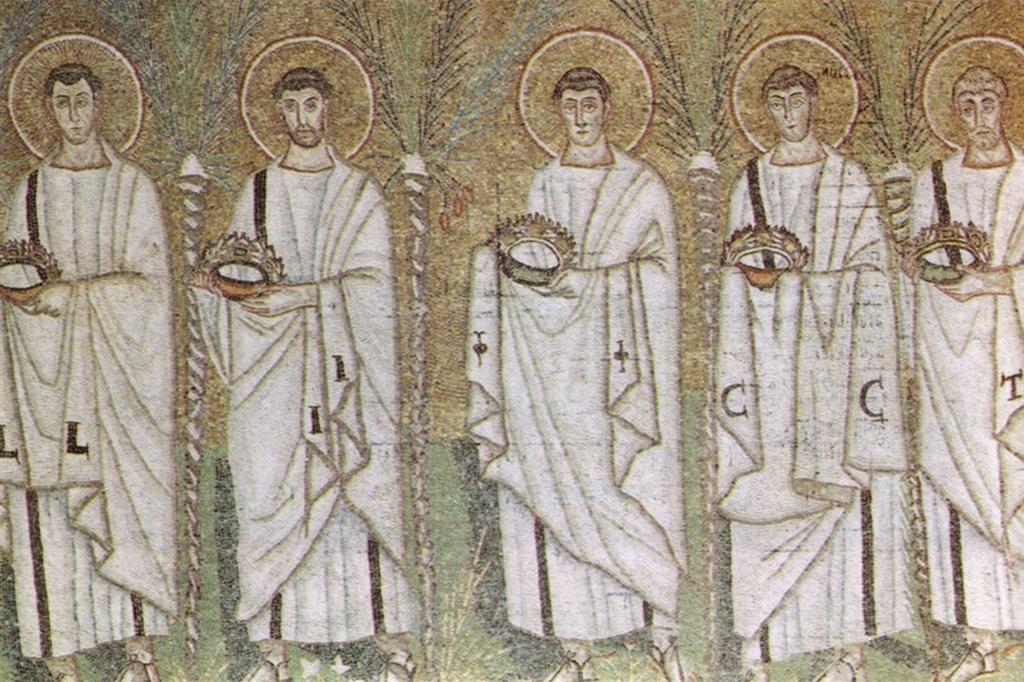
Ravenna, Sant’Apollinare Nuovo: ‘Santi Martiri’ (second half of the 6th century) – WikiCommons
“All those who believe in Christ, of any state or rank, are called to the fullness of Christian life and to the perfection of charity: this holiness promotes a more humane standard of life in earthly society”. The volume by Massimo Naro takes its cue and life from this passage from Lumen gentium: Fullness of life. Theology starting from believing experiences, released in these days for the types of the Studium publishing house (pages 477, euro 39). We publish here an excerpt from the ‘Presentation’ signed by the Prefect of the Congregation for the Causes of Saints, Cardinal Marcello Semeraro.
What is immediately striking is the title of the volume: Fullness of life, which alludes to Christian holiness as a gracious opportunity to experience “a more humane standard of living”, as n. 40 of the conciliar constitution Lumen gentium. It seems to me an important emphasis. A quick passage of the exhortation corresponds to her Gaudete et exsultate of Pope Francis, where we read: «Holiness does not make you less human, because it is the encounter of your weakness with the power of grace. After all, as León Bloy said, in life ‘there is nothing but sadness, […] that of not being holy ‘”(n. 34). A fundamental aspect of the saint’s identity is thus highlighted: he is not the superhero, who proceeds victorious, on his horse and with a flower in his mouth, in a field populated by the defeated, but a man who has experienced his fragility. and his vulnerability and that precisely in them he encountered God and in this encounter he found himself (…). To further accompany these lines intended to encourage the reading of Massimo Naro’s work, I would add a warm exhortation from Bishop Tonino Bello, of whom the pope has recently recognized the heroic exercise of virtues: “Above all, be men. Until the end. Indeed, up to the top. Because to be men to the top means to be holy. Do not stop, therefore, halfway up: holiness does not tolerate discrete measures ». If the title of the volume is able to give the right pitch to the reading of him, the subtitle is no less important. In publishing, in fact, it sometimes happens that the titles chosen are a sort of mirror of the larks in order to convince readers to buy, perhaps leaving them then disappointed. Here it is exactly the opposite. What does the expression ‘lived believers’ mean (which recalls the reflections of Jean Mouroux and Giovanni Moio-li), Naro explains immediately in his introduction and in fact coincides with the third criterion that guided him in the drafting of this work undoubtedly rich and relevant. Ultimately, it is a memory to be preserved. The Christian – Pope Francis would say, using a story by Jorge Luis Borges ( Funes el memorioso, adapted from Ficciones, 1944) – is just a mindful. The very being of the Christian is a remembrance. A significant passage in this regard can be read in Evangelii gaudium: «Memory is a dimension of our faith that we could call ‘deuteronomic’, in analogy with the memory of Israel (…). The believer is fundamentally ‘one who remembers’ “(n. 13). I am truly grateful to Massimo Naro – to whom, in addition to the dear memory of his brother, the late Archbishop Cataldo, long friendship and esteem bind me for asking me to write a few lines of introduction. I am grateful to him if only because in this way he has offered me the opportunity to read these pages of his, undoubtedly rich and dense, in advance, in a phase of my life that leads me to focus my ministry and therefore my attention on the ’causes of the saints. ‘. The task of the Congregation for the Causes of Saints, in fact, is to deal with everything that, according to the prescribed procedure, leads to the beatification and canonization of the servants of God. with pleasure that in his work Naro also often makes use of Positio which are, in the curial language, the dossier containing the documents of the trial, that is the oral testimonies and the documents and acta causae, or the debate between the dicastery and the ‘actors’ of the cause, aimed at focusing on the various problems inherent in the life and activity of the servant of God. It is therefore extremely important documentary material. Naro frequently refers to them. Not only. With the rigor of the scholar that characterizes him, he observes that “those who want to know or deepen the knowledge” of a servant of God will have to consider the Positio like an insatiable source. This, however, does not mean that they are accessible to anyone and this not least because of the privacy that must be respected even in this case (…). Very useful, already at the introductory level, are the references to what Naro, in the wake of authors such as Hans Urs von Balthasar, Giovanni Moioli, François-Marie Léthel and others, calls “theological hagiography” and this in the right intention to overcome the “modern ‘divorce’ between theology and mysticism” (…). On the other hand, at the conclusion of the analysis of the profiles of holiness and believing experiences proposed in the volume, he notes that “in this way holiness reveals itself to be a concrete matter, within everyone’s reach” (…). In Gaudete et exsultateFrancesco in turn speaks of the holiness “next door”, identified “in the patient people of God: in parents who raise their children with love, in men and women who work to bring bread home, in the sick, in elderly religious who keep smiling. In this constancy to go forward day after day I see the holiness of the militant Church “(n. 7). The figures of holiness studied and presented in this volume are largely geographically and culturally located in Sicily and in contemporary times; not all, of course, since the series opens with Paolino di Nola – “deliberately called into question as a witness to the co-implication between learned faith and popular faith happily possible in the patristic era” – and continues with spiritual personalities of the seventeenth and eighteenth centuries, such as the Jesuit of Spanish origin Luigi La Nuza. Neither are, in any case, figures for whom a canonical process for beatification and canonization has been initiated or concluded. All, in any case, are emblematic spiritual personalities in the perspective of the author and beyond, which is why they appear for example – the Sturzo brothers together with a group of founders of religious and secular institutes or exemplary bishops, as well as highly representative significant figures of contemporary Italian Catholicism, such as Lorenzo Milani, Giorgio La Pira, Divo Barsotti, Chiara Lubich (…). The look on the “sacrament of the poor” of which Blessed James Cusmano spoke is also very significant: a theme that echoes what some Fathers of the Church already taught in this regard, such as Chrysostom and Nazianzen, and then again famous French preachers such as Jacques Bénigne Bossuet and even more explicitly Henri-Dominique Lacordaire, who said that “the poor are a sacrament, just as they are a mystery: they are an intermediate sacrament, which does not require any preparation on our part, but which communicates grace and it disposes us to receive the fruit of the sacraments properly called ”. But even in contemporary France this theme has been taken up again, for example by Olivier Clément (…). The pages dedicated to Blessed Pino Puglisi and the proposal for a “rethinking of martyrology” demand attention and acribia. In this regard, Naro quotes the sentence pronounced by John Paul II in the Valley of the Temples about “martyrs for justice and indirectly for the faith”. There is no doubt that the extemporaneous or simply homiletical context of this and similar affirmations raises instances of discernment. The reflection on the expansion of the martyr’s identity is, in any case, a question to be taken into serious consideration (…). The volume ends with the figure of Archbishop Cataldo Naro, a quotation of which already appears in the exergue. Bibliographic references to his writings also appear here and there in the text, signs of a life as a scholar and pastor dedicated to the Church and his history and who in the service of the Church concluded his earthly life; a life during which, as the title of the chapter dedicated to him says, he started trials and sowed the future. Among the reflections that, at the end of the reading, will arise in the soul, this one, which I draw from the exhortation Gaudete et exsultate, to which the concluding pages of the book also refer, and which could be an encouragement to carefully read the volume by Massimo Naro: “It is not possible for a Christian to think of his mission on earth without conceiving it as a journey of holiness, because this your sanctification is God’s will ‘(1 Thes 4: 3). Each saint is a mission; it is a plan of the Father to reflect and incarnate, in a determined moment of history, an aspect of the Gospel ».
Spirituality. The faith of the saints: the accomplished humanity

